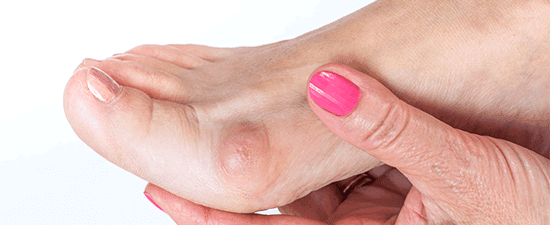- Home
- Foot & Ankle Conditions
- Morton's Neuroma
Morton's Neuroma: causes, symptoms and treatments
- Published 12/7/2018
- Last Reviewed 10/8/2024
What is Morton's neuroma?
A neuroma is a benign growth that involves thickening and inflammation of nerve tissue that results in pain or a burning sensation. A Morton's neuroma is found in the tissue of the toes.
The thickening of the nerve that characterizes a neuroma is often the result of compression and irritation. This compression not only enlarges the nerve but can also lead to more severe symptoms and potentially permanent nerve damage if not addressed.
Symptoms of Morton’s neuroma include pain in the ball of the foot, feeling like you’re standing on a pebble, burning pain, foot pain or numbness.
- What are common causes of Morton's neuroma?
- What are common risk factors for Morton's neuroma?
- How is Morton's neuroma diagnosed?
- Nonsurgical treatments for Morton's neuroma
- Advanced Morton's neuroma treatment options
- Why UFAI is the best choice for Morton's neuroma care?
- Morton's neuroma FAQs
- What kind of doctor treats Morton's neuroma?
- Can Morton's neuroma cause leg or calf pain?
- What are the best shoes to wear for Morton's neuroma?
- What does Morton's neuroma look like?
- Can Morton neuroma cause sciatica?
- Can Morton's neuroma cause numb toes?
- Can Morton's neuroma come back?
- Can an X-ray show Morton's neuroma?
- What can be mistaken for Morton's neuroma?
-
ABFAS® Board Certified in Foot and Ankle Surgery and Co-Director of University Foot and Ankle Institute
Board-Certified Podiatric Foot and Ankle Specialist, Dr. Gary Briskin, DPM, FACFAS, began his medical training by serving a residency at Flint General Hospital in Michigan. Once completed, he established a practice in Century City Hospital, where he soon became chief of podiatric surgery.
Dr. Briskin is a Diplomat of the American Board of Podiatric Surgery and a Fellow of the American College of Foot and Ankle Surgeons. He also serves as an assistant clinical professor at the UCLA School of Medicine and is co-founder and co-director of University Foot and Ankle Institute.
-
ABFAS® Board Certified in Foot Surgery and Reconstructive Rearfoot and Ankle Surgery. and Director of University Foot and Ankle Institute
Dr. Bob Baravarian DPM, FACFAS is a Board-Certified Podiatric Foot and Ankle Specialist. He is an assistant clinical professor at the UCLA School of Medicine and serves as Director of University Foot and Ankle Institute.
Dr. Baravarian has been involved in athletics his entire life and played competitive tennis in high school and college. He has an interest in sports medicine, arthritis therapy, and trauma/reconstructive surgery of the foot and ankle. He is also fluent in five languages (English, French, Spanish, Farsi, and Hebrew),
Learn More from our Morton's Neuroma Blog Articles
 All I can say about this place is, you will see miracles with your own eyes. I went to their office in Sherman Oaks and I had a...Allen S.
All I can say about this place is, you will see miracles with your own eyes. I went to their office in Sherman Oaks and I had a...Allen S. Please provide handicap parkingBarry S.
Please provide handicap parkingBarry S. Dr. Ambibola Johnson is awesome!Laurie S.
Dr. Ambibola Johnson is awesome!Laurie S. I appreciate the care and timeliness of all my appointments I’ve had at UFAI. Gray, Lydia and the staff all are wonderful. Lydi...Edelmira G.
I appreciate the care and timeliness of all my appointments I’ve had at UFAI. Gray, Lydia and the staff all are wonderful. Lydi...Edelmira G. Very greatfull for the doctor and stuffJesus M.
Very greatfull for the doctor and stuffJesus M. Doctor was very caringBrigitte S.
Doctor was very caringBrigitte S. Dr. Bob is the best. I had an infection in my big toe and he basically saved my foot. And he has the best staff in town, to boot!Jon S.
Dr. Bob is the best. I had an infection in my big toe and he basically saved my foot. And he has the best staff in town, to boot!Jon S. Everyone is very nice and efficient-
Everyone is very nice and efficient-
Especially Dr Kelman. He takes very good care of me!!Claudia K. Great costumer service.
Great costumer service.
Prompt and efficientDean W. I always love coming in to see Dr Franson and the staff that work there. Because they are very friendly and compassionate.Steven G.
I always love coming in to see Dr Franson and the staff that work there. Because they are very friendly and compassionate.Steven G. No . I’m pleased with the care .Michael P.
No . I’m pleased with the care .Michael P. Appreciate the professionalism and expertise, as well as the caring.Stella G.
Appreciate the professionalism and expertise, as well as the caring.Stella G.



